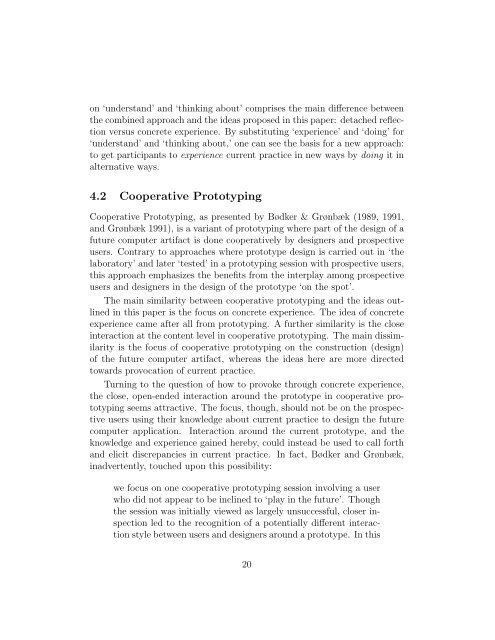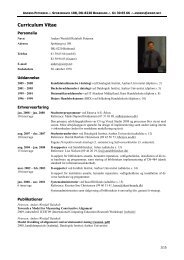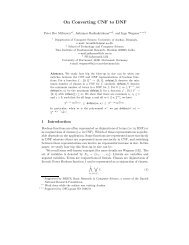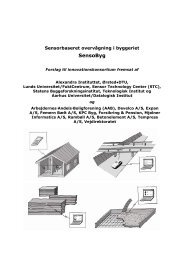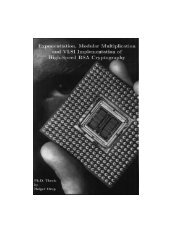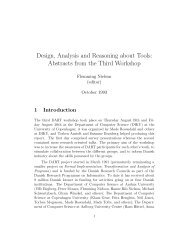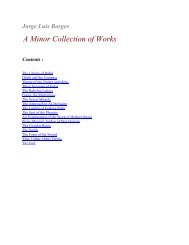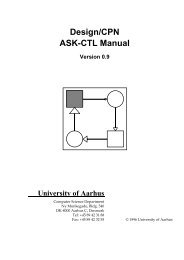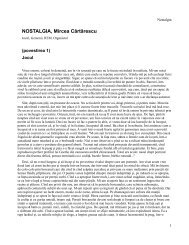towards a provotyping approach in systems development
towards a provotyping approach in systems development
towards a provotyping approach in systems development
Create successful ePaper yourself
Turn your PDF publications into a flip-book with our unique Google optimized e-Paper software.
on ‘understand’ and ‘th<strong>in</strong>k<strong>in</strong>g about’ comprises the ma<strong>in</strong> difference between<br />
the comb<strong>in</strong>ed <strong>approach</strong> and the ideas proposed <strong>in</strong> this paper: detached reflection<br />
versus concrete experience. By substitut<strong>in</strong>g ‘experience’ and ‘do<strong>in</strong>g’ for<br />
‘understand’ and ‘th<strong>in</strong>k<strong>in</strong>g about,’ one can see the basis for a new <strong>approach</strong>:<br />
to get participants to experience current practice <strong>in</strong> new ways by do<strong>in</strong>g it <strong>in</strong><br />
alternative ways.<br />
4.2 Cooperative Prototyp<strong>in</strong>g<br />
Cooperative Prototyp<strong>in</strong>g, as presented by Bødker & Grønbæk (1989, 1991,<br />
and Grønbæk 1991), is a variant of prototyp<strong>in</strong>g where part of the design of a<br />
future computer artifact is done cooperatively by designers and prospective<br />
users. Contrary to <strong>approach</strong>es where prototype design is carried out <strong>in</strong> ‘the<br />
laboratory’ and later ‘tested’ <strong>in</strong> a prototyp<strong>in</strong>g session with prospective users,<br />
this <strong>approach</strong> emphasizes the benefits from the <strong>in</strong>terplay among prospective<br />
users and designers <strong>in</strong> the design of the prototype ‘on the spot’.<br />
The ma<strong>in</strong> similarity between cooperative prototyp<strong>in</strong>g and the ideas outl<strong>in</strong>ed<br />
<strong>in</strong> this paper is the focus on concrete experience. The idea of concrete<br />
experience came after all from prototyp<strong>in</strong>g. A further similarity is the close<br />
<strong>in</strong>teraction at the content level <strong>in</strong> cooperative prototyp<strong>in</strong>g. The ma<strong>in</strong> dissimilarity<br />
is the focus of cooperative prototyp<strong>in</strong>g on the construction (design)<br />
of the future computer artifact, whereas the ideas here are more directed<br />
<strong>towards</strong> provocation of current practice.<br />
Turn<strong>in</strong>g to the question of how to provoke through concrete experience,<br />
the close, open-ended <strong>in</strong>teraction around the prototype <strong>in</strong> cooperative prototyp<strong>in</strong>g<br />
seems attractive. The focus, though, should not be on the prospective<br />
users us<strong>in</strong>g their knowledge about current practice to design the future<br />
computer application. Interaction around the current prototype, and the<br />
knowledge and experience ga<strong>in</strong>ed hereby, could <strong>in</strong>stead be used to call forth<br />
and elicit discrepancies <strong>in</strong> current practice. In fact, Bødker and Grønbæk,<br />
<strong>in</strong>advertently, touched upon this possibility:<br />
we focus on one cooperative prototyp<strong>in</strong>g session <strong>in</strong>volv<strong>in</strong>g a user<br />
who did not appear to be <strong>in</strong>cl<strong>in</strong>ed to ‘play <strong>in</strong> the future’. Though<br />
the session was <strong>in</strong>itially viewed as largely unsuccessful, closer <strong>in</strong>spection<br />
led to the recognition of a potentially different <strong>in</strong>teraction<br />
style between users and designers around a prototype. In this<br />
20


